热图绘制
热图是做分析时常用的展示方式,简单、直观、清晰。可以用来显示基因在不同样品中表达的高低、表观修饰水平的高低等。任何一个数值矩阵都可以通过合适的方式用热图展示。
本篇使用R的ggplot2包实现从原始数据读入到热图输出的过程,并在教程结束后提供一份封装好的命令行绘图工具,只需要提供矩阵,即可一键绘图。
上一篇讲述了Rstudio的使用作为R写作和编译环境的入门,后面的命令都可以拷贝到Rstudio中运行,或写成一个R脚本,使用Rscript heatmap.r运行。我们还提供了Bash的封装,在不修改R脚本的情况下,改变参数绘制出不同的图形。
生成测试数据
绘图首先需要数据。通过生成一堆的向量,转换为矩阵,得到想要的数据。
- data <- c(1:6,6:1,6:1,1:6, (6:1)/10,(1:6)/10,(1:6)/10,(6:1)/10,1:6,6:1,6:1,1:6, 6:1,1:6,1:6,6:1)
- [1] 1.0 2.0 3.0 4.0 5.0 6.0 6.0 5.0 4.0 3.0 2.0 1.0 6.0 5.0 4.0 3.0 2.0 1.0 1.0
- [20] 2.0 3.0 4.0 5.0 6.0 0.6 0.5 0.4 0.3 0.2 0.1 0.1 0.2 0.3 0.4 0.5 0.6 0.1 0.2
- [39] 0.3 0.4 0.5 0.6 0.6 0.5 0.4 0.3 0.2 0.1 1.0 2.0 3.0 4.0 5.0 6.0 6.0 5.0 4.0
- [58] 3.0 2.0 1.0 6.0 5.0 4.0 3.0 2.0 1.0 1.0 2.0 3.0 4.0 5.0 6.0 6.0 5.0 4.0 3.0
- [77] 2.0 1.0 1.0 2.0 3.0 4.0 5.0 6.0 1.0 2.0 3.0 4.0 5.0 6.0 6.0 5.0 4.0 3.0 2.0
- [96] 1.0
注意:运算符的优先级。
- > 1:3+4
- [1] 5 6 7
- > (1:3)+4
- [1] 5 6 7
- > 1:(3+4)
- [1] 1 2 3 4 5 6 7
Vector转为矩阵 (matrix),再转为数据框 (data.frame)。
- # ncol: 指定列数
- # byrow: 先按行填充数据
- # ?matrix 可查看函数的使用方法
- # as.data.frame的as系列是转换用的
- data <- as.data.frame(matrix(data, ncol=12, byrow=T))
- V1 V2 V3 V4 V5 V6 V7 V8 V9 V10 V11 V12
- 1 1.0 2.0 3.0 4.0 5.0 6.0 6.0 5.0 4.0 3.0 2.0 1.0
- 2 6.0 5.0 4.0 3.0 2.0 1.0 1.0 2.0 3.0 4.0 5.0 6.0
- 3 0.6 0.5 0.4 0.3 0.2 0.1 0.1 0.2 0.3 0.4 0.5 0.6
- 4 0.1 0.2 0.3 0.4 0.5 0.6 0.6 0.5 0.4 0.3 0.2 0.1
- 5 1.0 2.0 3.0 4.0 5.0 6.0 6.0 5.0 4.0 3.0 2.0 1.0
- 6 6.0 5.0 4.0 3.0 2.0 1.0 1.0 2.0 3.0 4.0 5.0 6.0
- 7 6.0 5.0 4.0 3.0 2.0 1.0 1.0 2.0 3.0 4.0 5.0 6.0
- 8 1.0 2.0 3.0 4.0 5.0 6.0 6.0 5.0 4.0 3.0 2.0 1.0
- # 增加列的名字
- colnames(data) <- c("Zygote","2_cell","4_cell","8_cell","Morula","ICM","ESC","4 week PGC","7 week PGC","10 week PGC","17 week PGC", "OOcyte")
- # 增加行的名字
- # 注意paste和paste0的使用
- rownames(data) <- paste("Gene", 1:8, sep="_")
- # 只显示前6行和前4列
- head(data)[,1:4]
- Zygote 2_cell 4_cell 8_cell
- Gene_1 1.0 2.0 3.0 4.0
- Gene_2 6.0 5.0 4.0 3.0
- Gene_3 0.6 0.5 0.4 0.3
- Gene_4 0.1 0.2 0.3 0.4
- Gene_5 1.0 2.0 3.0 4.0
- Gene_6 6.0 5.0 4.0 3.0
虽然方法比较繁琐,但一个数值矩阵已经获得了。
还有另外2种获取数值矩阵的方式。
读入字符串
- # 使用字符串的好处是不需要额外提供文件
- # 简单测试时可使用,写起来不繁琐,又方便重复
- # 尤其适用于在线提问时作为测试案例
- > txt <- "ID;Zygote;2_cell;4_cell;8_cell
- + Gene_1;1;2;3;4
- + Gene_2;6;5;4;5
- + Gene_3;0.6;0.5;0.4;0.4"
- # 习惯设置quote为空,避免部分基因名字或注释中存在引号,导致读入文件错误。
- # 具体错误可查看 http://blog.genesino.com/collections/R_tips/ 中的记录
- > data2 <- read.table(text=txt,sep=";", header=T, row.names=1, quote="")
- > head(data2)
- Zygote X2_cell X4_cell X8_cell
- Gene_1 1.0 2.0 3.0 4.0
- Gene_2 6.0 5.0 4.0 5.0
- Gene_3 0.6 0.5 0.4 0.4
可以看到列名字中以数字开头的列都加了X。一般要尽量避免行或列名字以数字开头,会给后续分析带去一些困难;另外名字中出现的非字母、数字、下划线、点的字符都会被转为点,也需要注意,尽量只用字母、下划线和数字。
- # 读入时,增加一个参数`check.names=F`也可以解决问题。
- # 这次数字前没有再加 X 了
- > data2 <- read.table(text=txt,sep=";", header=T, row.names=1, quote="", check.names = F)
- > head(data2)
- Zygote 2_cell 4_cell 8_cell
- Gene_1 1.0 2.0 3.0 4.0
- Gene_2 6.0 5.0 4.0 5.0
- Gene_3 0.6 0.5 0.4 0.4
读入文件
与上一步类似,只是改为文件名,不再赘述。
- > data2 <- read.table("filename",sep=";", header=T, row.names=1, quote="")
转换数据格式
数据读入后,还需要一步格式转换。在使用ggplot2作图时,有一种长表格模式是最为常用的,尤其是数据不规则时,更应该使用 (这点,我们在讲解箱线图时再说)。
- # 如果包没有安装,运行下面一句,安装包
- #install.packages(c("reshape2","ggplot2"))
- library(reshape2)
- library(ggplot2)
- # 转换前,先增加一列ID列,保存行名字
- data$ID <- rownames(data)
- # melt:把正常矩阵转换为长表格模式的函数。工作原理是把全部的非id列的数值列转为1列,命名为value;所有字符列转为variable列。
- # id.vars 列用于指定哪些列为id列;这些列不会被merge,会保留为完整一列。
- data_m <- melt(data, id.vars=c("ID"))
- head(data_m)
- ID variable value
- 1 Gene_1 Zygote 1.0
- 2 Gene_2 Zygote 6.0
- 3 Gene_3 Zygote 0.6
- 4 Gene_4 Zygote 0.1
- 5 Gene_5 Zygote 1.0
- 6 Gene_6 Zygote 6.0
- 7 Gene_7 Zygote 6.0
- 8 Gene_8 Zygote 1.0
- 9 Gene_1 2_cell 2.0
- 10 Gene_2 2_cell 5.0
- 11 Gene_3 2_cell 0.5
- 12 Gene_4 2_cell 0.2
- 13 Gene_5 2_cell 2.0
- 14 Gene_6 2_cell 5.0
- 15 Gene_7 2_cell 5.0
- 16 Gene_8 2_cell 2.0
分解绘图
数据转换后就可以画图了,分解命令如下:
- # data_m: 是前面费了九牛二虎之力得到的数据表
- # aes: aesthetic的缩写,一般指定整体的X轴、Y轴、颜色、形状、大小等。
- # 在最开始读入数据时,一般只指定x和y,其它后续指定
- p <- ggplot(data_m, aes(x=variable,y=ID))
- # 热图就是一堆方块根据其值赋予不同的颜色,所以这里使用fill=value, 用数值做填充色。
- p <- p + geom_tile(aes(fill=value))
- # ggplot2为图层绘制,一层层添加,存储在p中,在输出p的内容时才会出图。
- p
- ## 如果你没有使用Rstudio或其它R图形版工具,而是在远程登录的服务器上运行的交互式R,需要输入下面的语句,获得输出图形 (图形存储于R的工作目录下的Rplots.pdf文件中)。
- ## 如何指定输出,后面会讲到。
- #dev.off()
热图出来了,但有点不对劲,横轴重叠一起了。一个办法是调整图像的宽度,另一个是旋转横轴标记。
- # theme: 是处理图美观的一个函数,可以调整横纵轴label的选择、图例的位置等。
- # 这里选择X轴标签45度。
- # hjust和vjust调整标签的相对位置,具体见 <https://stackoverflow.com/questions/7263849/what-do-hjust-and-vjust-do-when-making-a-plot-using-ggplot>。
- # 简单说,hjust是水平的对齐方式,0为左,1为右,0.5居中,0-1之间可以取任意值。vjust是垂直对齐方式,0底对齐,1为顶对齐,0.5居中,0-1之间可以取任意值。
- p <- p + theme(axis.text.x=element_text(angle=45,hjust=1, vjust=1))
- p
设置想要的颜色。
- # 连续的数字,指定最小数值代表的颜色和最大数值赋予的颜色
- # 注意fill和color的区别,fill是填充,color只针对边缘
- p <- p + scale_fill_gradient(low = "white", high = "red")
- p
调整legend的位置。
- # postion可以接受的值有 top, bottom, left, right, 和一个坐标 c(0.05,0.8) (左上角,坐标是相对于图的左下角计算的)
- p <- p + theme(legend.position="top")
调整背景和背景格线以及X轴、Y轴的标题。(注意灰色的背景没了)
- p <- p + xlab("samples") + theme_bw() + theme(panel.grid.major = element_blank()) + theme(legend.key=element_blank())
- p
合并以上命令,就得到了下面这个看似复杂的绘图命令。
- p <- ggplot(data_m, aes(x=variable,y=ID)) + xlab("samples") + theme_bw() + theme(panel.grid.major = element_blank()) + theme(legend.key=element_blank()) + theme(axis.text.x=element_text(angle=45,hjust=1, vjust=1)) + theme(legend.position="top") + geom_tile(aes(fill=value)) + scale_fill_gradient(low = "white", high = "red")
图形存储
图形出来了,就得考虑存储了,
- # 可以跟输出文件不同的后缀,以获得不同的输出格式
- # colormode支持srgb (屏幕)和cmyk (打印,部分杂志需要,看上去有点褪色的感觉)格式
- ggsave(p, filename="heatmap.pdf", width=10,
- height=15, units=c("cm"),colormodel="srgb")
至此,完成了简单的heatmap的绘图。但实际绘制时,经常会碰到由于数值变化很大,导致颜色过于集中,使得图的可读性下降很多。因此需要对数据进行一些处理,具体的下次再说。



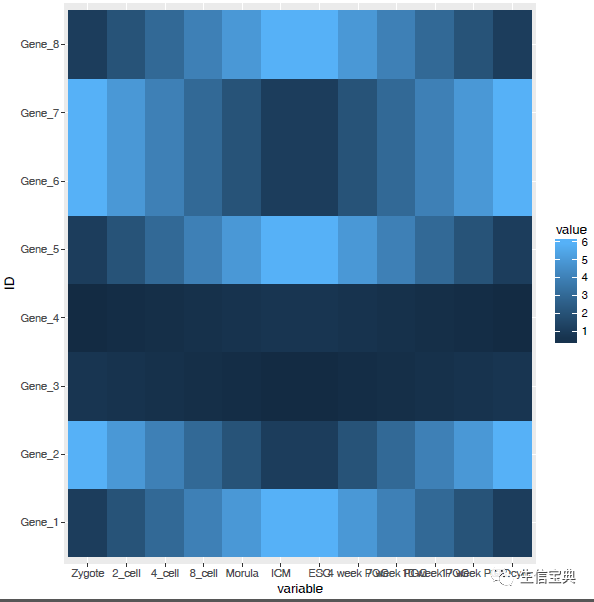
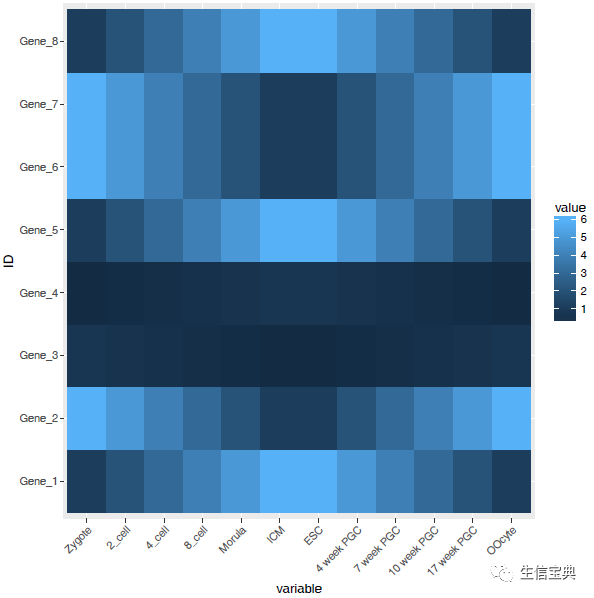
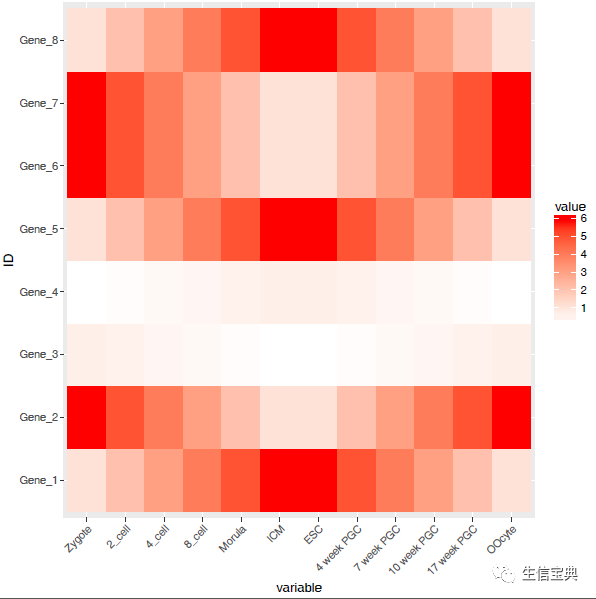
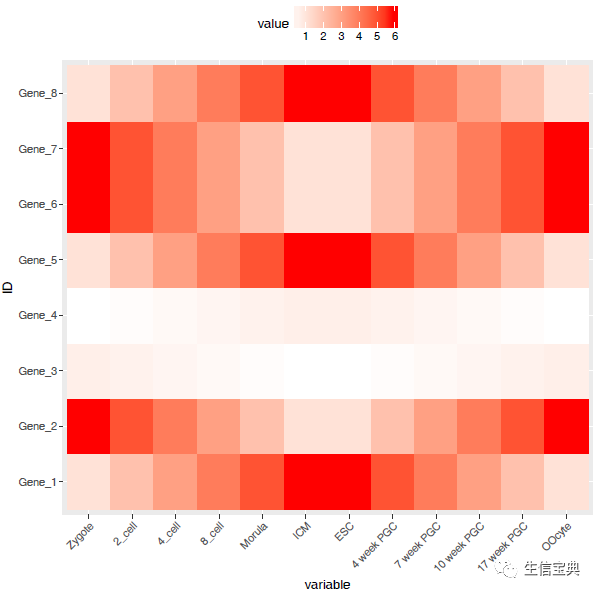
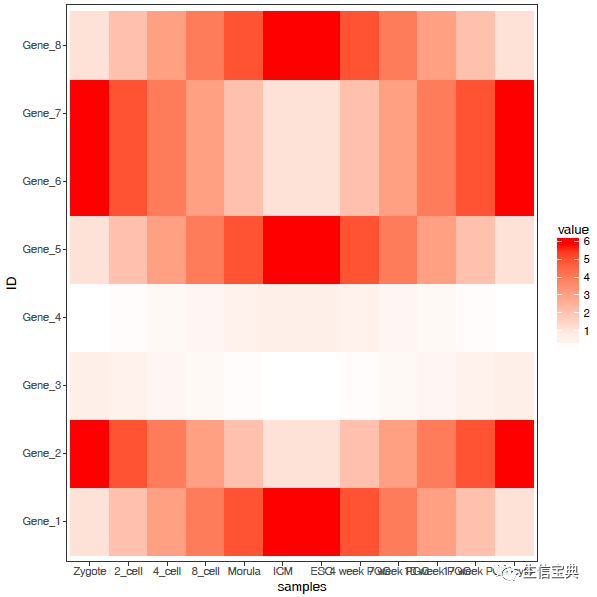
1F
这篇文章太优秀了。手把手教学,我搜了这么多教程都没有办法拼凑出一个满意的热图,感谢!
2F
楼主您好 感谢您写了这个教程,请问我在这个输入完填充颜色改为红色渐变化代码的时候,为什么图没变红 我按照这个教程一步步走的